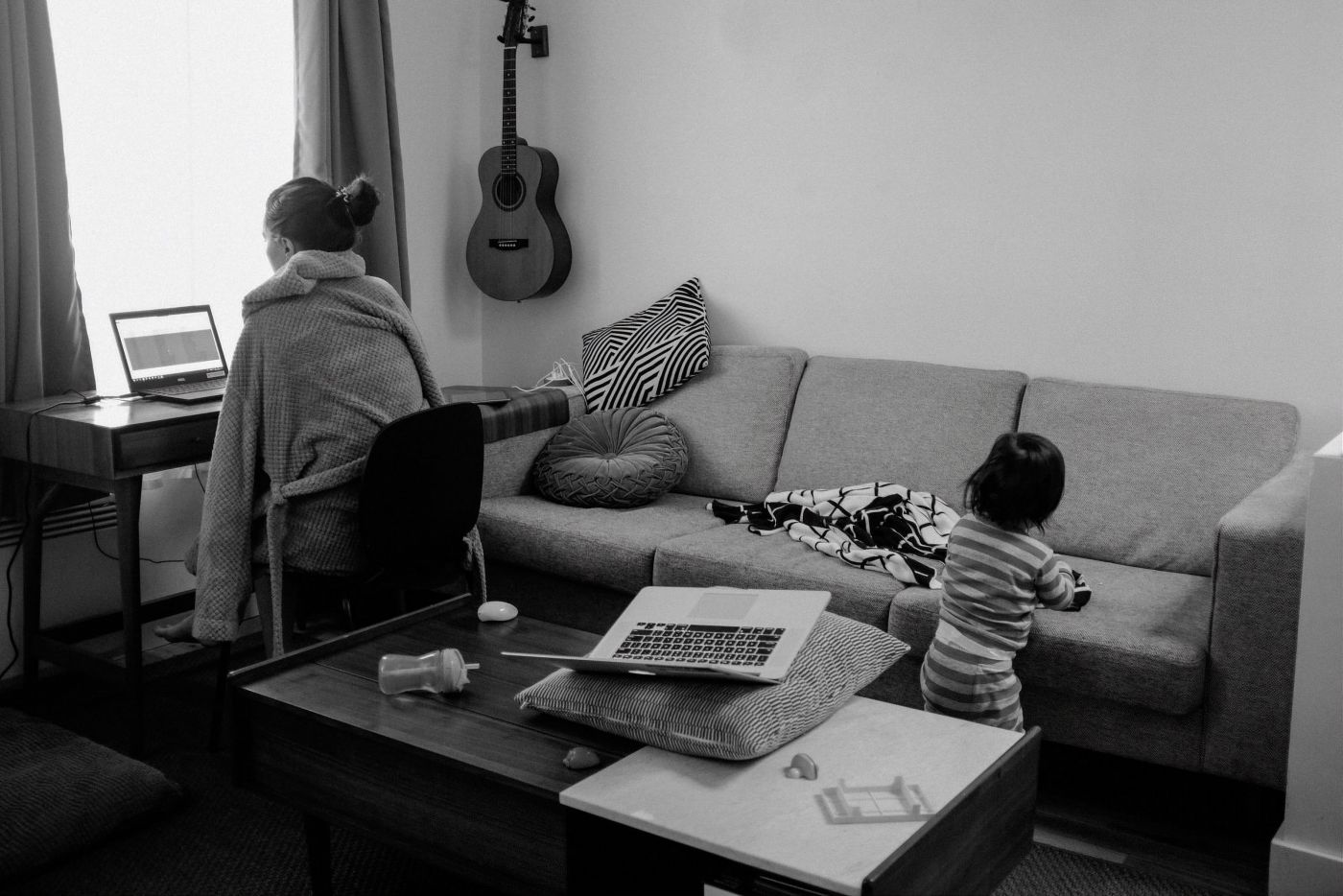Stretches of long winter months lie ahead. Beyond cold weather and shorter days, this year, we also have to deal with continually changing social distancing mandates and health protocols. All while a record number of Americans continue to work from home.
I’m a veteran remote worker with a partner who also WFH. I recently relocated to the east coast for my first full winter in a while—during a pandemic no less. As such, I’ve acquired my fair share of tips. But these aren’t your old and tired WFH hacks, like “clear off your desk.” These are actionable and specific tactics that I’ve honed (and borrowed from my remote colleagues as well) to keep my sanity.
1. Plan Your Day to Prioritize Exercise
Exercise and activity are essential when working from home. A scientific study compared workers who exercised during the day to those who didn’t and concluded that working out improved both mood and productivity. Another study confirmed this, reporting that active and fit individuals experience better overall job performance.
Unfortunately, winter can be a brutal time to get motivated. Depending on your location, outdoor workouts may be out of the question. You’re so far from the need for a “beach bod” that it doesn’t seem worth the effort. Plus, it’s cold and dark. While I understand all of that, moving your body will make a massive difference in your day-to-day effectiveness.
The thing is, if you just tell yourself you’ll work out, you won’t. You won’t stay consistent or accountable. You’ve got to schedule it like you would a Zoom team meeting.
To ensure I get enough exercise in, I plan my entire day around it, from when I’m going to wash my hair to what I’m wearing to the projects I tackle, and especially how I eat. It may seem like overkill, but those small intentional decisions allow me to keep a steady routine.
To get started, simply plan your meals/eating and schedule the optimal time to squeeze in a workout. I typically opt for late morning or late afternoon, so I can eat a few hours before I exercise. But test out times and figure out what works best for your body.

Make the most of your schedule and workouts by eating the right foods. For pre-workout, the experts at HealthMarkets advise, “load up on healthy carbohydrates one to four hours before your exercise session. This means choosing whole grains (complex carbohydrates) when you can and selecting foods low in fat that also have low or moderate protein content.” When it comes to post-workout, they recommend eating a meal with light, lean protein as soon as possible, “Protein helps repair the small tears in muscle fibers that have been damaged during exercise.”
2. Work Intuitively
Working from home can get monotonous, especially if you’re confined to the same space to work, live, play, eat, and sleep. What’s more, blips of seasonal depression can further decrease your motivation and drive.
So while there are a zillion articles and advice out there with WFH tips—one important factor is to do what feels right for you in the moment. For example:
- Switch up your location: I’m a big proponent of dedicated workspaces with proper ergonomics. But sometimes I just want to be comfy on the couch. If you have a lazy Monday, work wherever feels best. Maybe that’s under a blanket or standing at a kitchen counter.
- Embrace the flow: For those with flexible schedules, take advantage of it! Sometimes you just can’t bring yourself to work. If so, take a slower morning, then work into the evening. Alternatively, if you’re really in the flow—work later one day and cut out early the next.
- Work hard, play hard: As humans, we need breaks and fun. Make sure to reward yourself for hard work. After you finish a grueling project, take a break to play with your pet, read a book, have a snack, or choose another fave activity.
- Increase snoozing as needed: Do you ever notice how you want to sleep more in the winter? It’s due to our circadian rhythms, especially for those who live in cold and snowy states. If you feel like your body needs more sleep, listen to it. Stay in bed a bit longer (one of the best WFH perks), or take a lunchtime nap.

3. Limit Social Media
This WFH tip is tough if your job involves social media (like mine) but still not impossible. Social media can be such a non-productive vortex of your time and also cause serious mental health ramifications.
Have you ever quickly popped on Instagram, lost track of time, then had trouble getting back into the zone or focusing? That’s because the infinite scroll function of the major social channels is deliberately addictive. Scientific studies confirm the addictive nature of social media and messaging platforms. Moreover, increased social media use can lead to fatigue, anxiety, depression, and FOMO.
Making matters worse, these sneaky social media breaks that steal your focus, energy, and productivity, can then force you to work later than needed to make up for procrastination. You’ll be tired at 6 p.m. with unfinished tasks on your to-do list and not sure why you haven’t gotten more done. It’s a common tale.
Put these actions into place to cut out unnecessary personal social media time:
- Place your phone face down or away from your desk when you work. (Research shows that even the presence of a smartphone can reduce cognitive ability).
- Turn off notifications or mute your phone so they don’t distract you. Turn off desktop notifications for your personal profiles as well.
- If you need to be on social media for work, do so on your computer instead of your phone.
- Don’t view scrolling as a break—instead of browsing Twitter on your lunch break, give your eyes a screen break by reading a book, listening to a podcast or music, taking a walk.

4. Use Timers and Alarms
This is one of the more simple tactics that will make a huge difference—incorporating timers and alarms into your day. When working from home, you can easily get lost in a project or spend too much time completing a task. On the flip side, you may feel unproductive at the end of the day and question what you really got done. Both scenarios are inevitable when WFH.
Use a time tracking tool to log your work and get a broad overview of your day. Apps like Harvest offer simple desktop plugins so you can quickly click a timer when switching between tasks, clients, or projects. (To find the best option for you, check out this Zapier list).
Surprisingly, looking at a timesheet can be extremely satisfying and eye-opening. For example, things like emails and phone calls can add up and make you feel like you haven’t accomplished as much (but in reality, you are working). You can also audit your workflow to understand if you spend too much or little time on specific tasks. It was truly a game-changer for me that I’ve since recommended to multiple WFH colleagues.
Additionally, start using alarms throughout your workday. Again, it can be easy to get wrapped up in work and forget about other necessities. Consistent alarms can remind you to pause, move your body, eat lunch, and more. Use your phone or a smartwatch to set up regular reminders. For instance, I have daily alarms that ping me to take walks around the block and stretch my arms in the afternoon (to counteract strain from typing all day).
5. Consider a (Safe) Change of Scenery
If it’s the dead of winter and you’re nearing WFH burnout, treat yourself to a change of scenery. One of the beauties of remote work is that you can be location-independent. Luxury hotels are offering day stays for remote workers who want to get away and work in style. HotelsByDay works with hotels throughout the U.S., so you can book local hotels at a discounted rate to make your daycation dreams come true.
You can either work in a new locale or take a PTO day and relax in a clean, comfy, safe space.
Don’t Just Survive the Winter But Thrive While WFH
Remote work has multiple benefits for your health, wellness, and career. Once you establish a routine and figure out what works for your happiness and productivity—it gets even better! The winter doesn’t have to be a miserable time. Stay active and positive, and use these tips to make remote work, work for you.

Image Credits:
Featured Image, “Working from Home” by Charles Deluvio via Unsplash
“Breakfast Granola” by Dan Counsell via Unsplash
“Work from Couch” by Windows via Unsplash
“Mobile Developer at Work” by Parker Byrd via Unsplash

